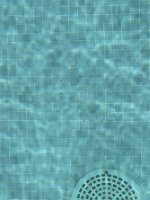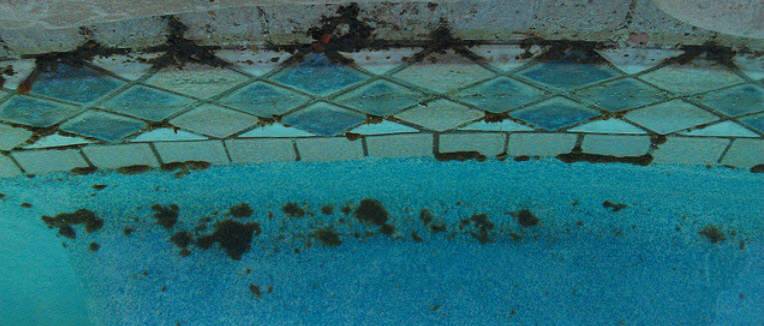- Aug 9, 2024
- 4
- Pool Size
- 40000
- Surface
- Plaster
- Chlorine
- Salt Water Generator
- SWG Type
- Hayward Aqua Rite Pro (T-15)
Hello!
I'm new here, and after using simple PH and Chlorine droplet measurement and color matching (given by the pool builder) for a while and di-clor shock every now and then (swim university recommended for SWG) I ended up with what looked like starting black algae developing in the deepest / shadiest areas of my pool:


After looking online, I bought a metal brush, and after brushing with that I shocked w/ 3x the diclor amount. It has been roughly a week, brushing every 2x days or so, the pump and SWG running 24/7 since then, and shocking once more in the middle. Black algae seems to be going away (yay!):


My pool:
- 7x4m gunite, with gresite, ~40.000 Liters
- Salt water generation
- PH pump
- Sand filter
- 1 CV pump
* Set to 8 hours of filtration in summer (likely that wasn't enough... right?)
* Every now and then, doing shock w/ granular di-clor
After discovering TFP and reading the website, I bought the Taylor K-2006 (I wasn't able to buy the salt version in Spain, but I have test strips for that), and I just did my first set of measurements today:
Free Chlorine - 19
Combined Chlorine - 1
PH - 7.4
Total Alkalinity - 40
Calcium Hardness - 410
CYA 35~40
This will allow me to be more certain of the free chlorine and other levels, instead of relying on the CL/PH drops and some test strips I had a while back and didn't trust much.
What would you do at this point?
The test strips I used in the past always reported very low / zero CYA and TA. To increase alkalinity, in the past I did put a couple times 6 Kg of
sodium bicarbonate (in the two years I have had the pool), which temporarily increased alkalinity but it quickly went back to zero (given the test strips readings). What could be the root cause of this? Should I try adding more now given that I have the Taylor kit and can better monitor this?
For CYA, I was concerned that algae growth was due to clorine not working OK due to levels >100 because of the di-clor shocking, but doesn't seem to be the case. Should I use some old tablets I have around to try to increase CYA? Or other ways?
Finally, lately I have been seeing some scaling, like a white crust building up on the edges of some of the gresite pieces, is this due to the high Hardness? Should I try to lower this?
If I had to guess, black algae started appearing due to lack of brushing (I do vacuum regularly, but likely didn't brush enough!) and maybe chlorine levels being too low due to only running 8 hours a day during hot weather (peaks of 34-37 degC during the day).
Thanks for all your recommendations in advance!!!
I'm new here, and after using simple PH and Chlorine droplet measurement and color matching (given by the pool builder) for a while and di-clor shock every now and then (swim university recommended for SWG) I ended up with what looked like starting black algae developing in the deepest / shadiest areas of my pool:


After looking online, I bought a metal brush, and after brushing with that I shocked w/ 3x the diclor amount. It has been roughly a week, brushing every 2x days or so, the pump and SWG running 24/7 since then, and shocking once more in the middle. Black algae seems to be going away (yay!):


My pool:
- 7x4m gunite, with gresite, ~40.000 Liters
- Salt water generation
- PH pump
- Sand filter
- 1 CV pump
* Set to 8 hours of filtration in summer (likely that wasn't enough... right?)
* Every now and then, doing shock w/ granular di-clor
After discovering TFP and reading the website, I bought the Taylor K-2006 (I wasn't able to buy the salt version in Spain, but I have test strips for that), and I just did my first set of measurements today:
Free Chlorine - 19
Combined Chlorine - 1
PH - 7.4
Total Alkalinity - 40
Calcium Hardness - 410
CYA 35~40
This will allow me to be more certain of the free chlorine and other levels, instead of relying on the CL/PH drops and some test strips I had a while back and didn't trust much.
What would you do at this point?
The test strips I used in the past always reported very low / zero CYA and TA. To increase alkalinity, in the past I did put a couple times 6 Kg of
sodium bicarbonate (in the two years I have had the pool), which temporarily increased alkalinity but it quickly went back to zero (given the test strips readings). What could be the root cause of this? Should I try adding more now given that I have the Taylor kit and can better monitor this?
For CYA, I was concerned that algae growth was due to clorine not working OK due to levels >100 because of the di-clor shocking, but doesn't seem to be the case. Should I use some old tablets I have around to try to increase CYA? Or other ways?
Finally, lately I have been seeing some scaling, like a white crust building up on the edges of some of the gresite pieces, is this due to the high Hardness? Should I try to lower this?
If I had to guess, black algae started appearing due to lack of brushing (I do vacuum regularly, but likely didn't brush enough!) and maybe chlorine levels being too low due to only running 8 hours a day during hot weather (peaks of 34-37 degC during the day).
Thanks for all your recommendations in advance!!!



